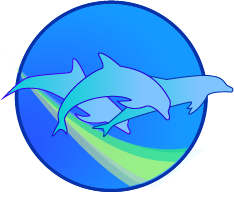Empathy from others and feeling understood have been shown to be essential to positive human growth and development throughout life, as infants, children, and adults. Empathy for others is an asset in personal and work relationships. Recognizing the importance of and finding ways to nurture empathy gained academic attention as recently as the 1980’s. How to teach and learn this communication skill has much to offer society but still puzzles investigators.
During 25 years of dolphin communication studies, I found that dolphins encourage and support empathy in humans. Dolphin contact is often reported in the same terms as Feeling Understood. Lack of connection in a dolphin experience elicits feelings similar to those in intimate human relations when we are isolated by the other’s inattention: “It hurts to reach out to someone who doesn’t respond,” (Nichols, p. 31).
How have dolphins received this power to hurt or uplift us? What can human-dolphin relations teach us about human relationships?
Dolphins are expert communicators. They have four separate voices, which they can use independently and simultaneously. They are very often in tactile and eye contact with each other. Dolphins have well developed frontal lobes cited to be a constituent of empathy in humans (Empathy: The State of the Art and Science, p. 16).
My mentor, Dr. John C. Lilly, described in detail their brains and abilities in several books, inspiring the producer of the Flipper TV series. He was the first to say that dolphins would be able to speak with us and the limitations of speaking with dolphins are with us rather than with them. He encouraged our pursuit of communication with dolphins, as a species with brains and intelligence equal to or greater than ours.
People now assume that dolphins are highly intelligent. This myth of dolphin intelligence colors our interactions with them. Leaders in human potential development have popularized dolphin contact, swimming with wild dolphins, fueling and capitalizing on this myth. People who go to the effort of seeking swimming with dolphins already have preconceptions in their mind. The Seeker’s esteem for the dolphin elevates them above other animals, and often characterizes them as more spiritually advanced than humans. Dolphins are being promoted as living in a higher dimension than we are but willing to help us get there.
In Dolphin Healing Dolphin Heart by Terry Walker (1998), I was quoted in the heading for a chapter, “The dolphins offer us this key to communication– friendship.” Despite how we define or prove intelligence in dolphins, despite their actual abilities, the pervasive image of dolphins allows people to enter into a special communication with them which is characterized by similar phrases as feeling understood. We approach them with respect, even honor and awe. We believe they are telepathic. We desire and sense a deep understanding and empathy from them. We go to them in deep friendship with a desire to be healed by them. We also desire to participate in healing the world and ourselves in order to help dolphins and the oceans that sustain them. In many cases, our empathic response for dolphins is greater than our empathy for humans.
The dolphin’s key to communication—the openness of genuine friendship– is the easiest way to explain ways we could improve our relationships. If only we approached others as we approach dolphins. We meet dolphins with a sense of sacred space, asking for blessings on the journey together. We watch for signs of hidden wisdom inside the other, anticipating that the other can read our thoughts and feels what we project into the space between us. We read compassion in eye-to-eye contact; we imagine deep knowingness bridging the distance between species. Imagine our conversations with people if we open up to deep friendship with others. By deep friendship I don’t mean merely passing as friendly, but having a genuine concern for the other’s well being, desire to understand and be understood by the other with respect for their good intentions and intelligence.
Think of situations in which we open up in friendship while communicating. For instance, in massage the practitioner opens herself to the client and in that space receives much more information about the client than is usually accepted in normal conversations. This is the sort of channel that seems to open in dolphin communication because of our beliefs and approach to the other. When my child is hurt, I find a place of empathy inside myself to say “I’m sorry” deeply, with feeling. Transferring that empathy so the child feels it too is often the only thing needed to stop the tears. As we communicate in heartfelt friendship, our communications will deepen. This applies to intrapersonal, interpersonal, global and even political communications.
In the table below: people who “feel understood” describe it as on the left. People who have had peak dolphin experiences use the words on the right to describe the experience. Notice the similarities.
- Feeling Understood
- Awakened
“I’m optimistic and cheerful, the world seems basically good and beautiful, men are essentially kind-life is worth living, the future seems bright.”
Senses open
No separation
Excitement, vitality
More alive
Brighter colors, vividness - Empowered
Accomplishment
Fulfillment
A unit
Stronger
Higher intellect, understanding - Comforted
Optimistic
Cheerful
Life worth living
Safe and secure
In harmony, in tune
No longer blocked - Moving toward
Trust
Appreciation, wanted, needed
Share, understanding
Touch
Unity, belonging
- Peak Dolphin Experience
- Aliveness
Awe, elation, deep joy
Unconditional love
Desire for more
Uniqueness
Stress reduction - Harmony
Harmony manifested
“Circle” created
Perceived patterns
Universe as integrated, unified,
Predictable and thereby
Healing - Connectedness
Enduring
Generalized to all other dolphins - Reciprocity
Eye-to-eye contact
Bonding
Crucial to sensing inner world of other
Copyright (c) Roberta Goodman. All rights reserved.
REFERENCES
Gordon, R., (1988) The Difference Between Feeling Defensive and Feeling Understood, Journal of Business Communication, V. 25. Ronald D. Gordon, Ph.D., is Professor of Communication at the University of Hawai’i at Hilo.
Peak Dolphin Experience descriptions come from:
DeMares, R., (2000) Human Peak Experience Triggered by Encounters with Cetaceans, Anthrozoos, 13 (2), pp. 89-103.

